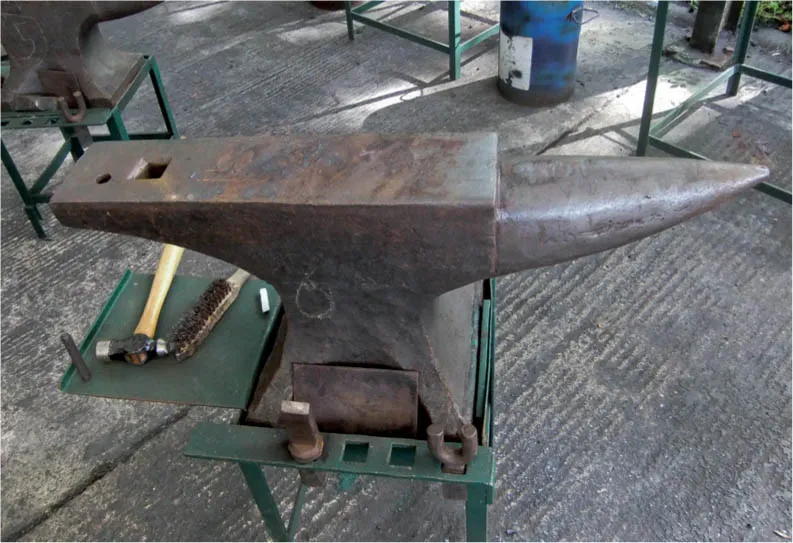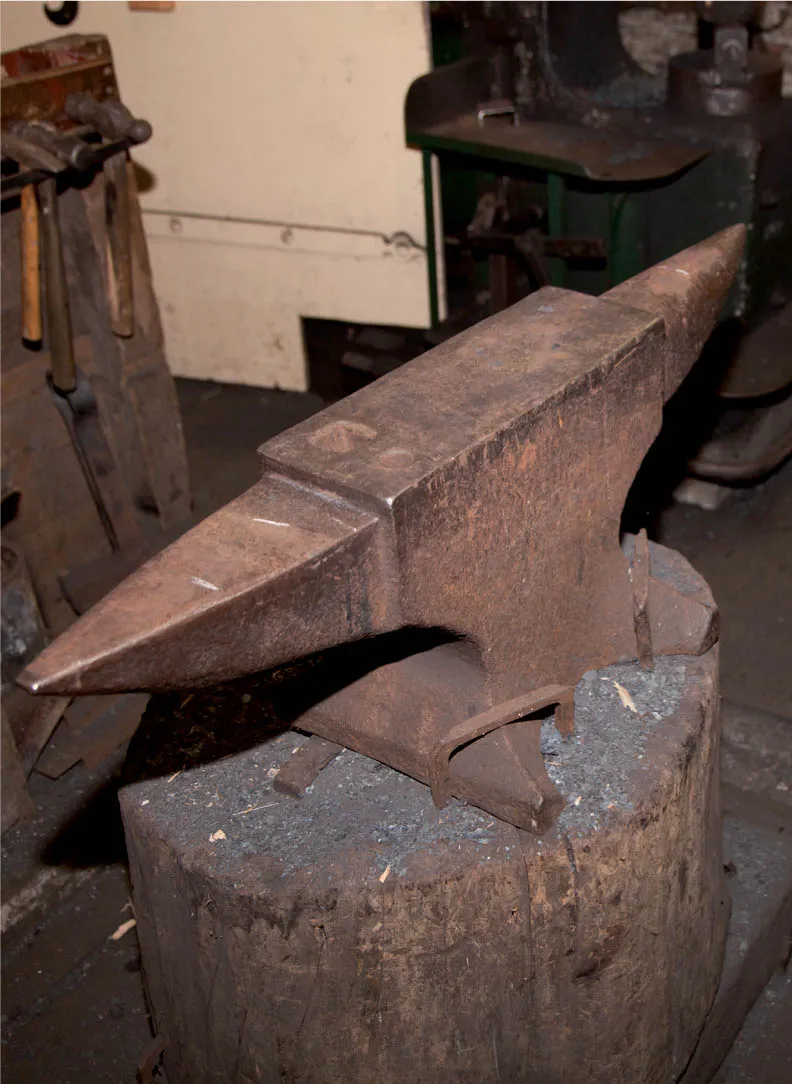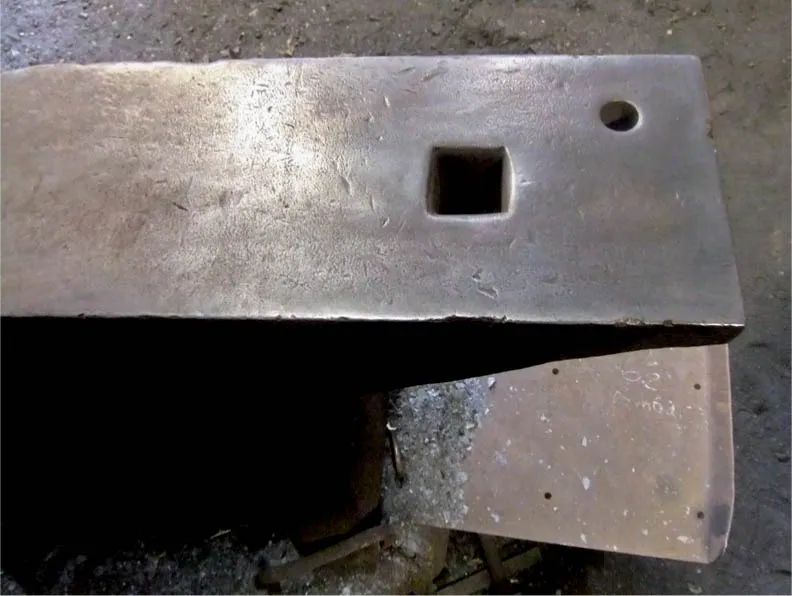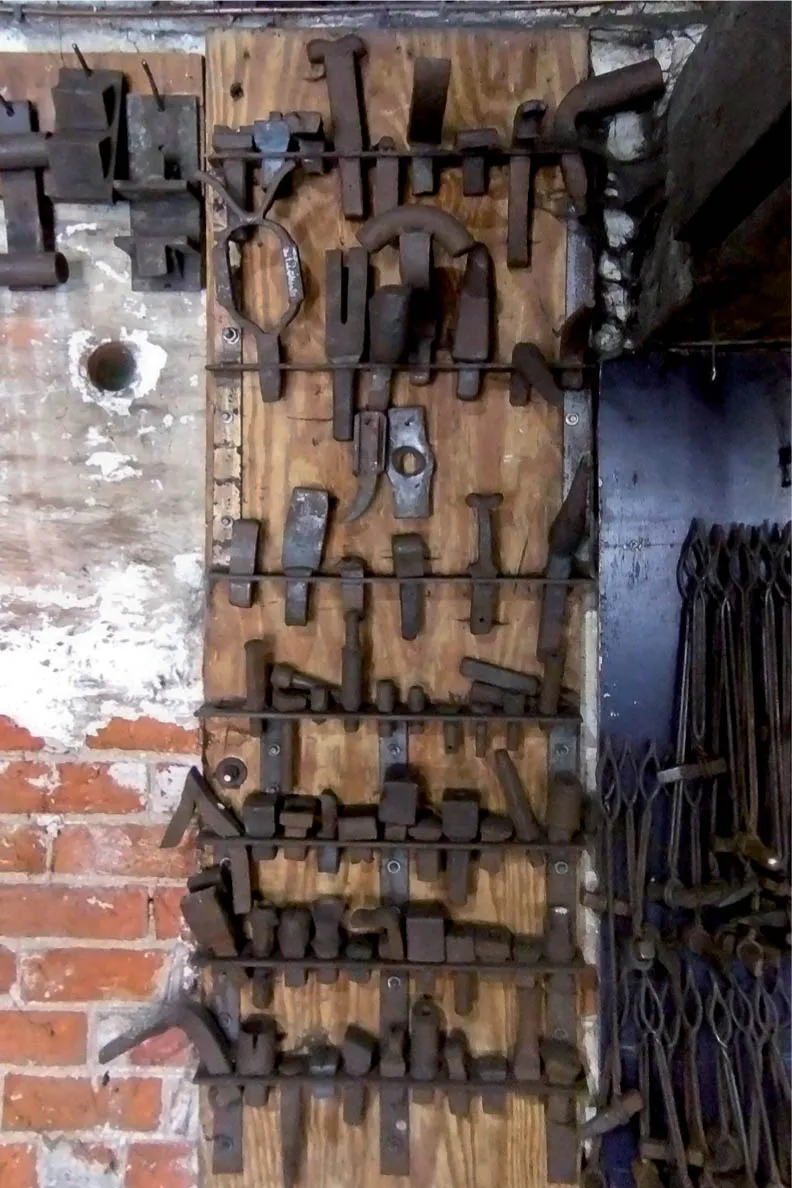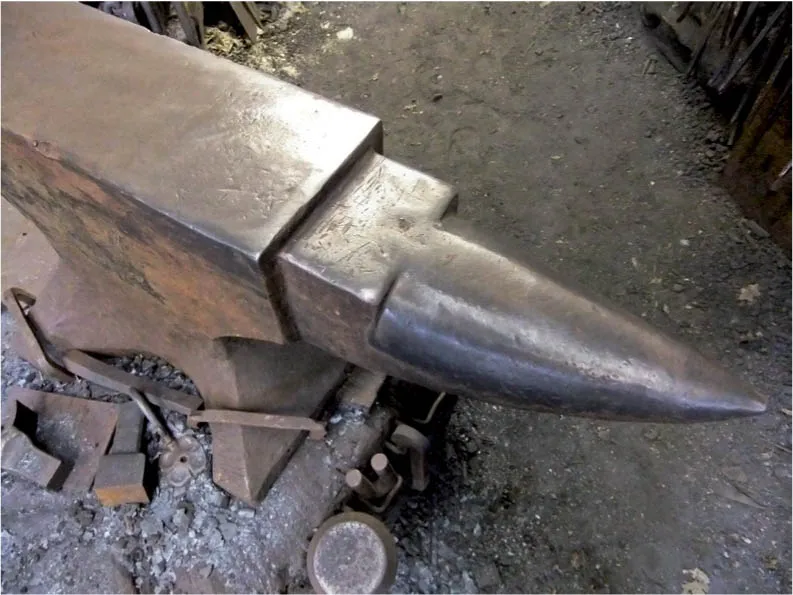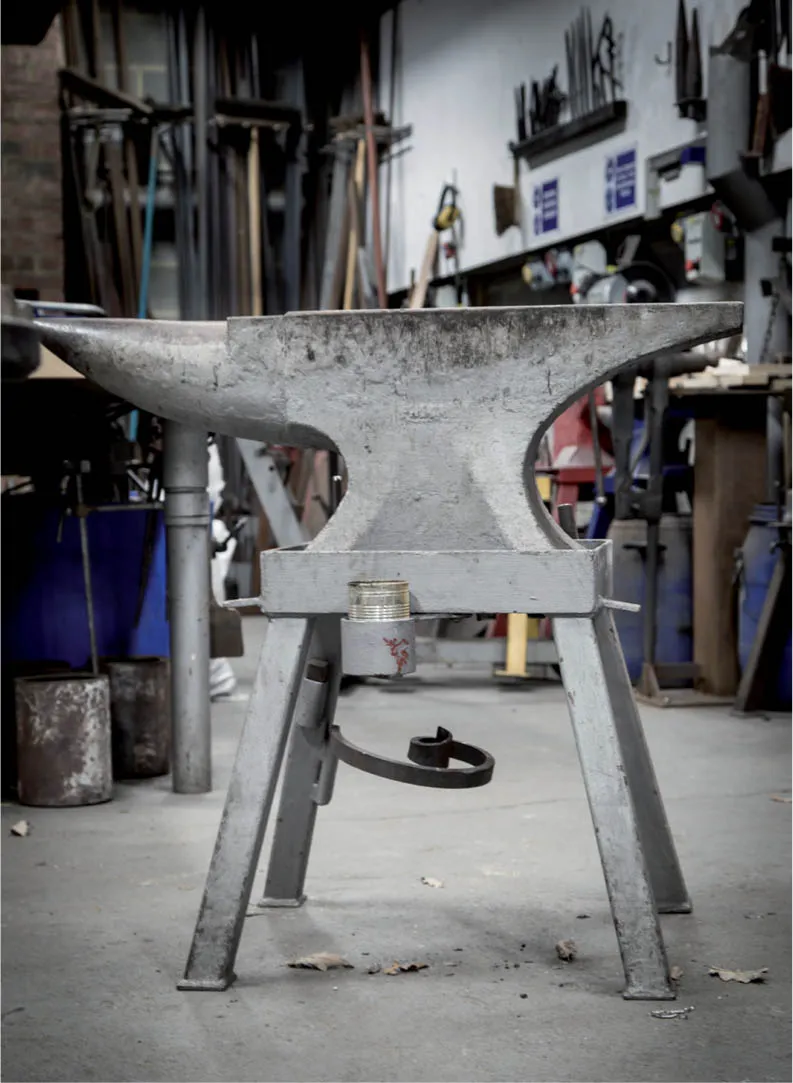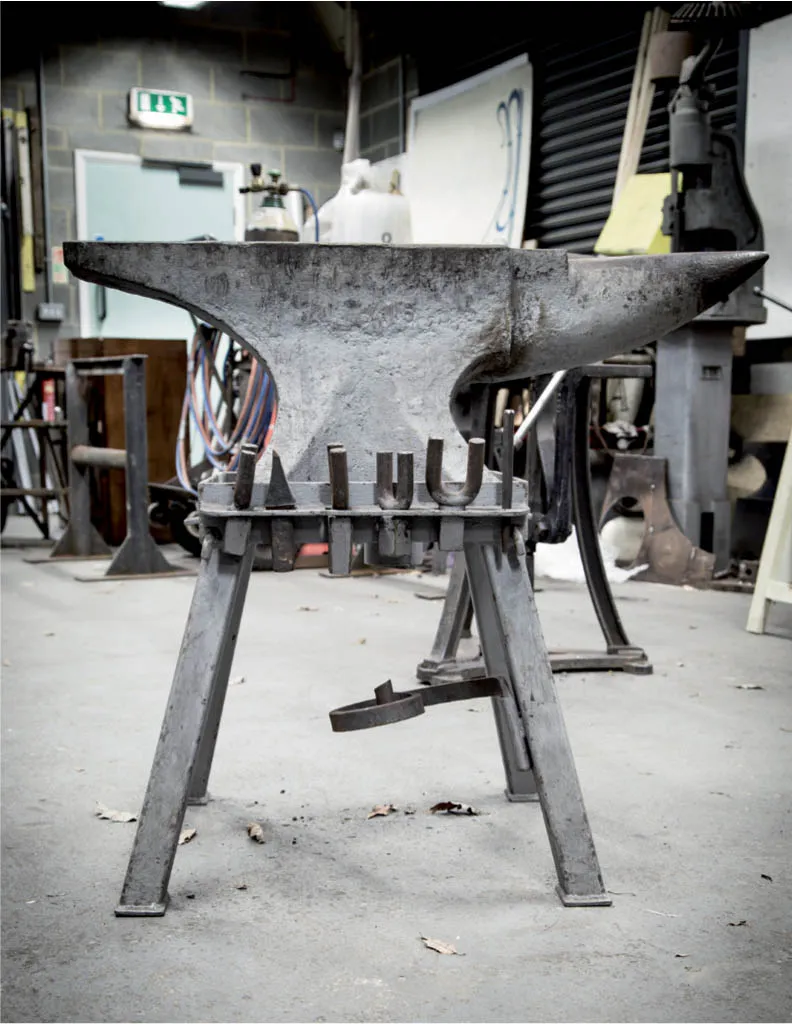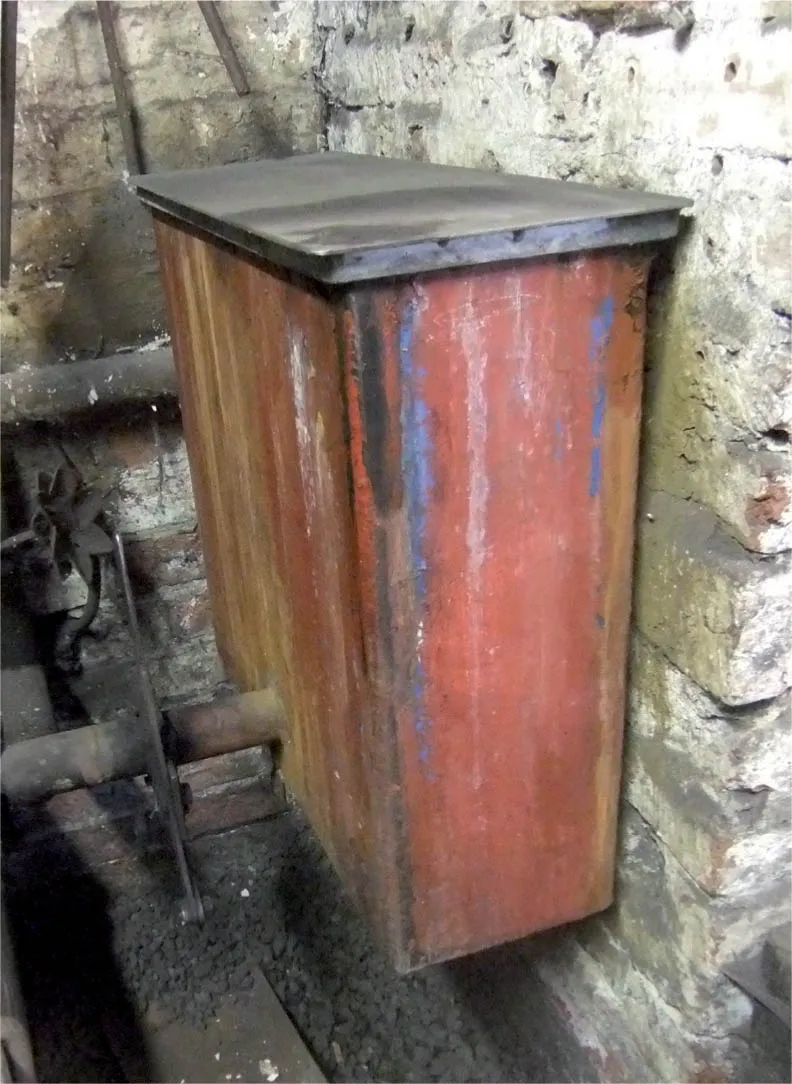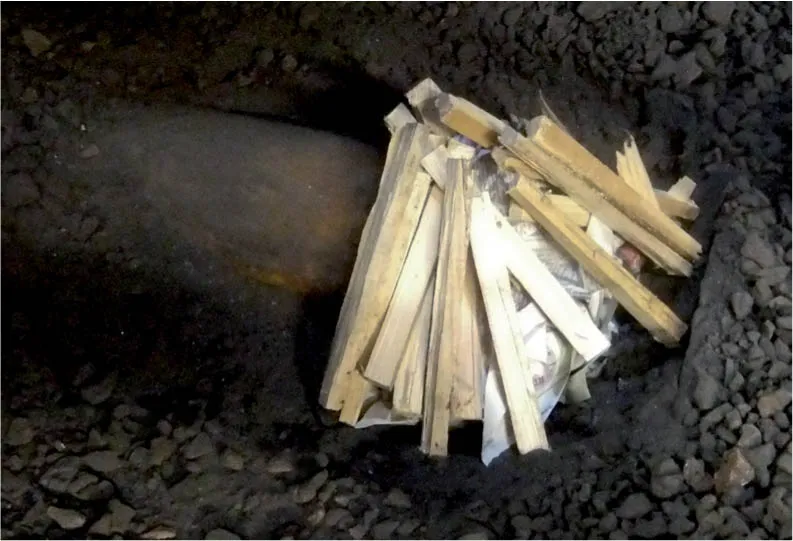![]()
CHAPTER ONE
GETTING STARTED
The anvil
The smith’s most important piece of equipment is his anvil. In Britain, the most usual kind of anvil is the London Pattern. This shape evolved about 300 years ago, and has hardly been bettered. There are also Birmingham Pattern and Portsmouth Pattern anvils in use, as well as various other slightly different models.
London Pattern anvil; the most popular shape used in Britain for 300 years. The height of the anvil should enable the smith to rest his hand upon the anvil while keeping the back straight.
Birmingham Pattern anvil; similar to London, but missing the table.
Portsmouth Pattern; similar to Birmingham, but with extra squared-off beak at other end.
Parts of the anvil
The beak, also called the bick, beck, pike, horn and other names, is the prominent characteristic of the anvil. Because of its tapering shape, it has an infinite number of radii, used in creating curves.
The square hole at the other end, the heel, of the anvil is called the hardie hole. It is so named after the cutting tool, which is the most frequently used anvil accessory. During a lifetime of working, a smith will invent – and copy – innumerable square-shanked tools to be secured in that hole.
Heel end of London anvil, showing hardie hole and pritchel hole.
Selection of tools for hardie and pritchel holes, where they can be seen.
Beside the hardie hole, there is another, smaller, round hole called the punch hole, or pritchel hole. This is used to support flat material when punching through the metal; because of its malleability, the material around the hole would otherwise be forced down around the hole and need re-flattening.
The face of the anvil is hardened. Even though the metal is hot and soft when it is being hit, the face needs to be hard wearing. Until the nineteenth century, anvils were made of wrought iron, and the face, of hard steel, was fire-welded on. After time in use, the body of the anvil would slightly compress at the left, most-used part of the face, and it would hollow. Forged (wrought iron) anvils have holes under the beak and heel where the huge tongs were deployed in placing the anvil in and out of the fire during manufacture. Present day anvils are usually cast steel, and have no holes. They do not hollow so much.
The beak is usually placed at the left when the anvil is used by a right-handed person. At the opposite side of the face, at the left hand end, is a small radius. This is used for a variety of reasons, which will be explained as we progress.
Radius at left end of face.
Height of the anvil
For ergonomic reasons, it is fairly important to adjust the height of your anvil to your needs. You can end up with a sore back if it is too high or low. To assess the height, stand beside the anvil, with your arm hanging down beside you and place the palm of the hand straight out, it should rest gently on the face of the anvil. If your arm is bent, the anvil is too high, and if you have to bend your body, it is too low.
Stand
Many anvils are supplied with a cast iron stand. These are usually too low, because they are meant to be used in an industrial situation, where a striker hits the tools upon the metal with a sledge-hammer. They also seem to increase the noise emitted by the anvil. In the traditional country smithy, the anvil was placed upon an elm trunk, which was sunk about two feet into the earth floor.
In a modern shop, where space is usually at a premium, a steel stand, which is movable, is convenient. Brackets for accessories and tools can be welded on to one of these stands, too.
Steel welded anvil stand, with retractable container for quenching pot in front of smith, and scroll iron in socket.
Other side of steel welded anvil stand, showing brackets for frequently-used tools.
FORGING SCALE
When you are forging, the hot metal oxidizes, shedding ‘scale’ (Fe3O4) on the anvil face. This scale is very hard, and can cause marks on the underside of the metal you are working. It is advisable to blow it off, or swipe it away, as you work.
The fire
Side blast and bottom blast
There are different kinds of fire – sometimes called a forge (but a forge can also refer to the building). The fire usually associated with rural and industrial use is the side blast, but the modern fire usually used abroad, and for the artist blacksmith, is the bottom blast.
The side blast has a tuyere (tue iron) through which the air is fed into the fire. It is made of either cast iron or mild steel, and has a double skin with water circulating inside. The water is fed from a bosh (tank) situated at the back of the fire and circulates by convection, to prevent the tue from overheating, which could cause it to burn. The danger in this is to forget to top up the water, and the tue burns out. This is a very expensive omission. Obviously the water evaporates, more so when hot, so that it is essential to check the water level every morning before lighting, and more so when using the fire at a high temperature.
Water bosh at back of fire, with air regulating valve.
The bottom blast is fed with air through a tue in the base of the fire.
The side blast fire is usually on a table with the supply fan underneath. There are quiet fans, which run all day unobtrusively, although some of the older types of fan make a terrible noise.
The base of the fire is forge dust, one of the inert products of combustion. The fuel sits on the dust, and is raked into the fire as needed.
The air supply needs to be variable. There are different kinds of valves for this job. Some fans have a motor whose speed can be regulated by a rheostat. If it is a noisy motor, this is essential, but it does not matter much with a quiet fan. The fire must be able to change for different conditions.
Lighting the fire
Old coke is raked away from the tue, exposing some clinker from the previous working. Clinker is the silicon from the fuel, turned into a crude form of glass, which drips down through the fire and forms a lump. Having a very high coefficient of expansion, it hardens as it cools and cracks with a ‘clink’ and hence the name.
Throw the clinker away, and make a dish-shaped depression in the dust, about 100 deep and 150 across, in front of the tue (side blast) or above the tue (bottom blast). There is always plenty of dust created during working, so some must be discarded each time you light. (Note: throughout the book, unless otherwise stated, measurements are given in mm, but in blacksmithing the unit is customarily omitted.)
Kindling sticks, about 125 long, will be needed, and some old newspaper. Roll up three or four sheets of paper into a ball, and place in the hole. Spread about fifteen sticks around the paper like a wigwam, and switch on the blower. The valve should be almost closed. Light the paper, and introduce a breath of air, sufficient to blow the flame on the paper. Keep an eye on the sticks, and when they start to flame, rake some (preferably old) coke onto the sticks. Always leave a hole in the top of the pile of sticks, to let the smoke out, and it will shortly ignite as a flame. Build the coke around the sticks and it will slowly ignite, and the whole thing will be ready to use in about five minutes.
Fire cleaned out, ready for lighting, showing side blast tuyere, ball of paper and kindling sticks.
Conserving fuel
Fuel is expensive, so keep the blast down most of the time. Metal will heat in its own good time, and regulation is slowly learned. Students and other learners have huge fires, wasting fuel. The experienced smith will work with about a quarter of the size of fire. One of the perils of big fires is that the temperature inside is beyond the burning point of steel, and irretrievable damage is easily done. Students’ scrap bins are full of burnt metal.
Watch the colour
It is best to keep withdrawing the metal from the fire constantly, to check the colour of the work. The progression of colours goes from black heat to maroon, to blood red, to bright red, to orange, to yellow, then white. Orange is the best colour to work with. Malleability changes radically through the colour range, and if you are trying to change the shape a lot, it needs to be orange.
The effectiveness of the hammer is dulled as the temperature drops. This is sometimes useful, because when, for instance, you are trying to impart a smooth finish to the work, blemishes can be removed with light blows at maroon heat.
Fire management
Fire management, or forge managemen...


